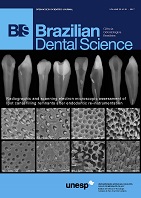Composite resin repairs: What is the most effective protocol?
DOI:
https://doi.org/10.14295/bds.2017.v20i1.1375Abstract
Objective: The objective of this study was to evaluate the combination effect of surface treatments and bonding agents on bond strength of repairs on aged composite resin. Materials and Methods: One hundred twenty microhybrid composite units (Filtek Z250) aged in distilled at 37ºC water for six months were submitted to different surface treatment prior to resin repairs. Ten specimens were randomly divided into 12 groups: non-treated/no bonding agent (negative control), sandblasting /no bonding agent, silane/no bonding agent, non-treated/ etch-and-rinse; non-treated/one-step self-etch; non-treated/ two-step self-etch; sandblasting/etch-and-rinse; sandblasting/one-step self-etch; sandblasting/two-step self-etch; silane coupling agent/etch-and-rinse; silane coupling agent/ one-step self-etch; silane coupling agent/two-step self-etch. Microshear testing was performed to bond strength assessment. Results: Two-way ANOVA and Tukey’s test (?=0.05) demonstrated significant difference between the surface treatments and adhesive systems. Only no treated surface/etch-and-rinse group showed lower bond strength values when compared to other groups. Conclusion: The considered surface treatments were capable to increase the effectiveness of the repair in composite resin when using the adhesive etch-and-rinse.Downloads
Downloads
Published
How to Cite
Issue
Section
License
Brazilian Dental Science uses the Creative Commons (CC-BY 4.0) license, thus preserving the integrity of articles in an open access environment. The journal allows the author to retain publishing rights without restrictions.
=================




























